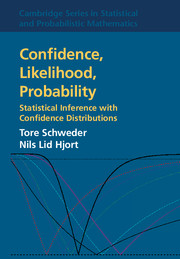Book contents
- Frontmatter
- Dedication
- Contents
- Preface
- 1 Confidence, likelihood, probability: An invitation
- 2 Inference in parametric models
- 3 Confidence distributions
- 4 Further developments for confidence distribution
- 5 Invariance, sufficiency and optimality for confidence distributions
- 6 The fiducial argument
- 7 Improved approximations for confidence distributions
- 8 Exponential families and generalised linear models
- 9 Confidence distributions in higher dimensions
- 10 Likelihoods and confidence likelihoods
- 11 Confidence in non- and semiparametric models
- 12 Predictions and confidence
- 13 Meta-analysis and combination of information
- 14 Applications
- 15 Finale: Summary, and a look into the future
- Overview of examples and data
- Appendix: Large-sample theory with applications
- References
- Name index
- Subject index
12 - Predictions and confidence
Published online by Cambridge University Press: 05 March 2016
- Frontmatter
- Dedication
- Contents
- Preface
- 1 Confidence, likelihood, probability: An invitation
- 2 Inference in parametric models
- 3 Confidence distributions
- 4 Further developments for confidence distribution
- 5 Invariance, sufficiency and optimality for confidence distributions
- 6 The fiducial argument
- 7 Improved approximations for confidence distributions
- 8 Exponential families and generalised linear models
- 9 Confidence distributions in higher dimensions
- 10 Likelihoods and confidence likelihoods
- 11 Confidence in non- and semiparametric models
- 12 Predictions and confidence
- 13 Meta-analysis and combination of information
- 14 Applications
- 15 Finale: Summary, and a look into the future
- Overview of examples and data
- Appendix: Large-sample theory with applications
- References
- Name index
- Subject index
Summary
The previous chapters have focussed on confidence distributions and associated inference for parameters of statistical models. Sometimes the goal of an analysis is, however, to make predictions about as yet unobserved or otherwise hidden random variables, such as the next data point in a sequence, or to infer values of missing data, and so forth. This chapter discusses and illustrates how the concept of confidence distributions may be lifted to such settings. Applications are given to predicting the next observation in a sequence, to regression models, kriging in geostatistics and time series models.
Introduction
In earlier chapters we have developed and discussed concepts and methods for confidence distributions for parameters of statistical models. Sometimes the goal of fitting and analysing a model to data is, however, to predict as yet unobserved random quantities, like the next observation in a sequence, a missing data point in a data matrix or inferring the distribution for a future Y0 in a regression model as a function of its associated covariates x0, and so on. For such a future or onobserved Y0 we may then wish to construct a predictive distribution, say Cpred(y0), with the property that Cpred(b)−Cpred(a) may be interpreted as the probability that a ≤ Y0 ≤ b. As such intervals for the unobserved Y0 with given coverage degree may be read off, via [C−1pred(α),C−1pred(1−α)], as for ordinary confidence intervals.
There is a tradition in some statistics literature to use ‘credibility intervals’ rather than ‘confidence intervals’, when the quantity in question for which one needs these intervals is a random variable rather than a parameter of a statistical model. This term is also in frequent use for Bayesian statistics, where there is no clear division in parameters and variables, as also model parameters are considered random. We shall, however, continue to use ‘confidence intervals’ and indeed ‘confidence distributions’ for these prediction settings.
We shall start our discussion for the case of predicting the next data point in a sequence of i.i.d. observations, in Section 12.2. Our frequentist predictive approach is different from the Bayesian one, where the model density is being integrated over the parameters with respect to their posterior distribution.
- Type
- Chapter
- Information
- Confidence, Likelihood, ProbabilityStatistical Inference with Confidence Distributions, pp. 336 - 359Publisher: Cambridge University PressPrint publication year: 2016



